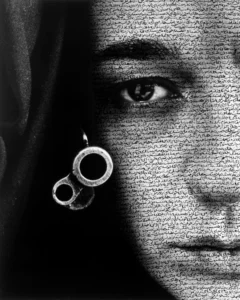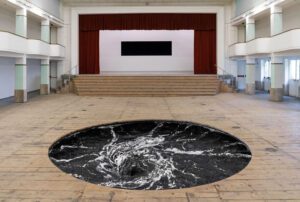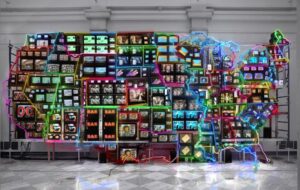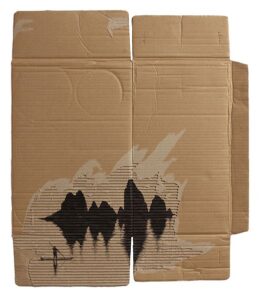Hari Yanto

Asia has a large population and a cultural diversity that has evolved over thousands of years. Asian cultures include Indian (Hindu), Chinese (Confucian and Buddhist), and the Arab (Islam) which has spread to various regions in Asia since the 8th century BCE. East Asian cultures like Japan and Korea have also influenced various parts of Asia. Southeast Asia is dominated by Malay culture which has become one of the more ethnically diverse regions in Asia.
A large part of Asia became a colony of the West. Since that time there has been deep contact between Asian and Western culture. As a result of decolonization across the region, there has been modernization in all areas. One of the most prominent Western influences is in the field of fine arts.
In the 20th century the region became independent. Post-colonial energy and discovery has been influential in the development of contemporary Asian art. At the end of the 20th century, Asia entered the era of globalization. Economic globalization has had positive and negative cultural influence.
Postmodern thought entered the Asian region. Postmodernism is synonymous with post-colonial in the field of Asian culture. Modernism in Western art has never recognized the existence of modernist art in Asia. Critics in the west still think of modern art in Asia as unauthentic. Postmodernism has a character that contrasts with modernism. Modernism glorifies universalism, regarded as Eurocentric, masculine and white. Most artists in the region have used postmodernism to fight against the domination of western art. Postmodern art reveals the spirit of the present or contemporary thought.
Contemporary art has a character that refuses the principle of modern art that is characterized by progressive left premodern cultural tradition and exalts the principle of originality in the creation of works of art. Contemporary art practice instead respects local culture and traditions. These become a theme or default materials in the production of contemporary art.
The works produced by contemporary Asian artists are mostly related to their local traditions. Chinese artists use material calligraphy, Japanese artists developed a tradition of art prints of the Edo period, and Indonesian artists are using puppet prototypes. Visual tradition that has developed in the territory of each culture is maintained and communicated, with the visual language related to the postmodern contemporary.
The strategy in the production of contemporary art made by the artists of Asia can be categorized with some of the terms such as negotiations with the tradition, reframing tradition, transformation of tradition, beyond tradition, deconstruction of tradition and so on. Wu Hung stated that the Chinese artists have been negotiating with their tradition by using three strategies, namely: distilling materiality, translating visuality, and refiguration.
Contemporary art is often paired with postmodern art in which the artist used to use a method or technique of appropriation and hybridization in realizing their visual concept. Discourse on local tradition communicated with international language (installation, performance art, video, and so on) so that contemporary art has a hybrid character. Appropriation techniques (lending/equalization) became one of the most frequently used by contemporary Asian artists.
Some of the reasons why the artists of Asia are still loyal to local traditions is because they reject the principle of originality in modernism, demonstrating the principle of authenticity demanded by western observers, and as a form of identity politics.
The Rise of Contemporary ArtAsia
In recent decades several countries in Asia have experienced a change of regime power and rapid socio-economic changes. China and India, the most populous, have experienced the most rapid economic growth. Past history and socio-economic changes in the countries in Asia have been influential in art practice. Art practice in the region cannot be separated from the interconnected history of the countries. Before the modern period, Asia as a whole was heavily influenced by India and China. Asian contemporary art with its western influences, has developed since the 1980s and has the character of avant-garde, post-colonial Europe.
Contemporary art in Asia (and the Pacific) in more modern times is in confrontation with the West. The development of contemporary art in Asia has been unable to follow western hierarchical models. Asian artists reject the very idea that their traditions and practices are inferior in cultural terms to western practices. Through the 1990s, when the Asian contemporary art was nascent but flowering, Euro-American paradigms were still prevalent but no more.

© FX Harsano
The 1990s was the era of revival of Asian contemporary art. To deal with the dominance of Euro-American art, Asian artists developed their own contemporary paradigms. At the same time bienniales and trienniales emerged in Asia. Some exhibitions held before the 1990s were: Indian Trienniale, Asian Art Biennale Bangladesh, and Fokuoka Asian Art Exhibition. The Asia-Pacific Trienniale (1993), Shanghai Biennale, Yokohama Trienniale, Kwangju Biennale, the Singapore Bienniale, and the Taipei Biennale. These have opened up new possibilities for the international stage. Biennales and triennales of contemporary art in various Asian cities each exhibit their own approach and perspective which is the engine of discussion for the future of Asian culture. The artists of the third world in Asia are in a unique position to remain in touch with their traditions.
Indonesia has also appeared in several biennales of contemporary art such as the Jakarta Biennale, Biennale Jogja, Biennale Bali and East Java Biennale. Besides biennales the are art fairs such as Artjog in Yogyakarta, Korea International Art Fair (Seoul), Affordable Art Fair Seoul, Art Taipei, Abu Dhabi Art, Singapore Art Fair, India Art Fair, Art Fair Tokyo, Art Beijing, Art Osaka and others. Asian contemporary art has grown into as important a creative industry as any in the west.
Artists from Asia mostly feature the works that show their identity as artists as distinct from the west. Each Asian artist draws upon their rich and diverse local traditions. Japanese artists highlight the pop art that comes from the tradition of the Edo period woodblock. The Chinese artists developed calligraphy and ink painting as a material in their installations and performance art. Indian women artists use bindis, the dot on the forehead of Hindu women, as an aesthetic concept all its own. Bamboo materials are used by artists from Japan, China, Indonesia dam others. Buddha figures are widely used by artists of Southeast Asia and East Asia. Artists from Indonesia use puppetry as a way of finding and centring their Javanese identity.
This revival of Asian contemporary art is not only marked by numerous art exhibitions (biennale, triennale, and art fair) in Asian cities, but also exhibitions of Asian art in Western countries, especially in America. The works of art from Asia, especially from China and Japan can fetch high prices in the global art market.
Re-Framing Local Tradition in Contemporary Fine Arts Asia

Exhibition at Galleria Continua, Italy 2015
© Anish Kapoor
The diversity of Asian contemporary art works can be viewed from various aspects: materials used, techniques and visual styles presented, according to the selected media, or themes and symbols grafted into the works. Most of the artists are still using conventional media such as painting, sculpture, and printmaking. Most Asian artists, while still using local materials or local traditions, are aware that the use of new media that quickly becomes the mainstream of contemporary art cannot be ignored. They deliberately marry these new media, such as installation, performance art, and video art, with the materials or elements of the local culture.
One universal element in Asian contemporary art is calligraphy. Iranian photographer Shirin Nesat often adds text in ‘Arabicton’ the body of the model in the photograph. Chinese artist Xu Bing frequently used Chinese calligraphy in his installations. Indonesian artist FX. Harsono also uses Chinese calligraphy in some installations.
One work of Shirin Neshat titled Spheechless (1996) is a series of photographic self-portraits in the form of close-ups, and on the side of her face there is a gun muzzle. This work depict sArab women in black costume always carrying a firearm; a picture of women in the era of the Iranian revolution. Feminists see this work as an illustration of the contrast between women in the west who are free and women of the east (Islam) who are restricted.
One of the works of Xu Bing using calligraphy is A Book from the Sky (1988); a very massive installation. Xu Bing presents hundreds of traditionally printed books of the Song Dynasty laid out neatly on the floor, while above the book hang dozens of meters of white cloth with Chinese characters of text. The irony is, this book cannot be read by observers.
FX Harsono is an Indonesian artist of Chinese descent, who is lately discoursing his life experiences as a minority. For over two decades Harsono has focused on the theme of identity politics. His personal experience is an endless source of inspiration. In the solo performance piece titled Erased Time at the National Gallery in 2009, Harsono demonstrated his ability to write his own name in Chinese characters. The resultant writings were then used as the main feature in the installation. Harsono works also contains quite sharp criticism of the New Order government policies that curb the rights of minority citizens to express their ancestral culture.
Between 2010-2013 Harsono participated in the project titled Edge of Elsewhere in a sub-urban community in Sydney. On that occasion Harsono showcased a video performance entitled Writing in the Rain (2011) which was a continuation of Erased Time (2009). Rewriting the Erased is a collaborative exhibition between Campbelltown Arts Centre and the Centre for Contemporary Asian Art, with invited artists in Asia-Pacific to engage directly with Erased (2009). This work is intended to recover the history of the forgotten citizens, and to communicate their narratives about their experiences of cross-cultures.
Other elements of traditional Asian art are ink painting, – landscapes that have evolved and survived for centuries in China (Guohua) and Japan (sumi-e). Ink painting with landscape objects and annotated with calligraphy have abounded. With the development of socialist realism and modernism, traditional ink painting had to fight for its place. After the death of Mao and Tiananmen Square, China’s traditional painting became popular again. Since the 1980s contemporary art in China became popular and many artists use visual idioms or language to portray their identity in their paintings. Chinese artists reinterpreted the art of landscape painting believing in the mantra that “the past is the future”.

The Chinese contemporary scene utilizes new media to realize their concept of nature. The work of Shen Fan, Landscape- Commemorating Huang Binghong (2006) is a masterpiece of light and sound installation composed of 2520 neon tubes. This work is intended to commemorate the landscape painter Huang Binghong, a master of the lines in his work. Shen Fan deliberately repeats a line from the landscape painting Binghong with his own line generated from the fluorescent light tubes. Shen Fan’s work pays homage to Binghong in this form of a two-way communication between tradition and modernity.
Duan Jianyu, a Chinese female artist, created images of traditional Chinese landscape painting in silhouettes painted on the surface of ripped carton packaging. Jianyu’s work is the deconstruction of the traditional Chinese landscape painting which has a classic character and is elitist. Through this work Jianyu wants to convey the message that the classical works of art can exist on modern materials that are cheaper and more populist.
Water is an important and sacred part of life. In Greek mythology Neptune is the god of the sea, which illustrates the belief that there is a master of the sea. Hindus believe the river Ganges is a sacred river. The majority of Indonesian people in rural hinterlands still believe that water has a latent strength. Water is a traditional element in many Asian initiation ceremonies. Many contemporary Asian artists use water both as a source of ideas as well as a material in their works.
Indian contemporary artists Subodh Kerkar, Anish Kapoor, and Vivan Sundaram are three artists who use water as a source material their work. Subodh Kerkar’s installation, The Earth Bowl (2011), is a bowl carved out of the flat rock at Ozran, Vagator beach, Anjuna. The bowl of this land will be filled with water with each tide. Anish Kapoor’s installation entitled Descension (2014), is a black vortex by an iron fence. A whirlpool that appears bottomless can be interpreted as something that can consume anything. Vivan Sundaram’s installation entitled Black Gold (2013), was created from fragments of pottery taken from an archaeological sites in Pattanam, a former port, that was destroyed by flooding.
Indonesian artist Sanjaya Tisna from Bandung initially cultivated the graphic arts in his practice. Lately his focus has been on social, political and environmental issues. In 2012 Tisna coperation with Greenpeace Indonesia to stage the performance art piece Urine Citarum in the village of Cigebar, in the Baleendah Bandung regency. The collaboration aims to provide a solution to the dying natural resources due to the omission, systemically from various parties, to undermine the vitality of the water and the environment. Tisna Sanjaya’s social art project for the last few years is in Cigondewah, a region ravaged by industrial agriculture. Through this project Tisna encourages local communities to get involved in fixing the region themselves.
Subodh Gupta is one of the Indian artists who transform everyday objects such as household appliances into a work of art that are readily accessible to a global audience. He gathered metal objects such as pots, buckets, tins and pans. In order to appropriate everyday objects and then turn them into works of art that dissolves the previous function and meaning – close to that of Duchamp’s joust with everyday objects. The Guardian dubbed Gupta the ‘Damien Hisrt of Delhi’ (Feb. 20, 2007).
Buddhism’s religious symbols are widely embraced by Asian artists. Nam June Paik, a Korean video artist, in some of his work displays Buddhist figures who are faced with a television monitor. In Reclining Buddha (1994) Paik presented a Buddha statue lying on two TV monitors that were showing the image of a naked woman. Golden Buddha (2005) is a video installation consisting of a golden Buddha statue facing the TV monitor equipped with video cameras that record images of other Buddha statues, so this Buddha was looking at his own face on the TV screen.
Identity Politics and Strategy, Creative Artists Asia

© Duan Jianyu
Identity politics refers to the idea that individuals tend to form their opinion on political issues on the basis of gender, race, ethnicity, and sexual orientation. Variations of identity politics can be seen in forms that would strive toward universal understanding or centre upon the aesthetics of the form.
The contemporary artists have been creating works that consciously identify themselves through various symbols, techniques, media, materials, or discourses that characterize Asia. All the artists of Asia also adhere to the principle or concept of cultural hybridization, also known as an eclectic creative strategy with elements of appropriation.
Cultural globalization has created a space in which on the one hand, uniformity, homogenization and cultural imperialism can be discerned, while the other hand, cross-cultural exchange and cultural enrichment form an extremely complex cultural map. Hybridization is the process of parasitism in a system in which an entity is used as a place to live off other entities, which can destroy both identity and otherness, even though the hybrid may establish its own identity.
The concept of hybridization is a key criticism in the study of post-colonial culture. It forms an argument in all debates on the appropriation of culture, and arises in conjunction with the concept of limits and the ideal cosmopolitan society. The function of hybridization, among others, concerns a mix of different phenomena that refers to the process of cross-category. Hybridization also functions as part of the power relationship between the centre and the edge, between hegemony and minorities, and blurs, destabilises or subverts the hierarchical relationship.
Eclecticism is a tendency in art, literature, design, and architecture that merges completely different styles and traditions forming a new style from the various artists or period chosen. Eclecticism can accommodate the interests of Asian artists. The artists chose eclecticism because it gives them the opportunity to scrutinize various styles, simultaneously. Contemporary artists present traditional images in a way or through a new approach such that their work cannot be categorized as traditional any more Installation, performance, video, and multimedia have brought conceptualism into the culture. The artists on the one hand presents the elements of tradition, on the other hand rejects the principle of traditionalism that is seen as static, while demonstrating to the West that they still hold authenticity as Asian. Eclecticism also signalled a rejection of the principles of originality and novelty upheld by modernism.
Appropriation had become a standard in the production of contemporary art. Appropriation in the production of contemporary art includes: remix, copy-paste, collage, montage, and quotations. Appropriation is a form of criticism of the myth of originality, authorship, and aura in modern art. The myth of modernist art is usually attributed to the dominance of male artists, so many female artists are found in the deconstruction of this mythos.
Re-Framing Art Tradition In The Production Of Asian Contemporary Art can be read as an attempt by Asian artists to resist the hegemony of western aesthetics that considered traditional art to be a lower form than European modern art. Asian artists want to show to western observers that they are authentic because they still show the characteristics of Asian culture and Asian identity. Most Asian artists believe that the past can be communicated by way of the present. Traditional art that is synonymous with the past is being re-interpreted, rediscovered, and repackaged as new in accordance with the contemporary scene.
Dialogue between traditional art and conceptual art is proof that contemporary art appreciates in practice the principles of relationships. Art is not a single individual. Fine arts and social plurality respect differences and diversity. With emphasis on the principles of relationships and pluralism of the Asian contemporary scene, art is seen as at least equal among collectors and western observers.
